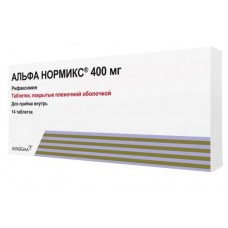Expiration date: 09/2027
The composition and form of issue:
Tablets, film-coated. 1 tablet contains:
rifaximin 200 mg
auxiliary substances: sodium starch of glycolate ether of glycerol palmitostearate silicon precipitated MCC talc hydroxypropyl methylcellulose titanium dioxide disodium edetate propylene glycol ferric oxide red E172
Description of dosage form:
Tablet: round biconvex tablet pink, film-coated.
Characteristic:
Broad-spectrum antibiotic, is a semi-synthetic derivative of rifamycin SV.
Pharmacokinetics:
Rifaximin is poorly absorbed when administered orally (less than 1%) and has an internal intestinal action. In the gastrointestinal tract, very high concentrations of antibiotic are created, which are significantly higher than MPC for tested enteropathogenic microorganisms.
The drug is not detected in plasma after taking therapeutic doses (limit of detection <0, 5-2 ng / ml) or detected in very low concentrations (<10 ng/ml in almost all cases) in both healthy volunteers and in patients with damaged intestinal mucosa (as a result of ulcerative colitis or Crohn's disease).
Almost 100% of the rifaximin, which came inside, is in the intestinal tract, where very high concentrations of the drug are achieved (concentrations in feces 4000-8000 mg/g are achieved through 3 days of treatment with a daily dose of 800 mg).
Detected in urine rifaximin is no more than 0, 5% of the oral dose.
Description of the pharmacological action:
Irreversibly binds to the beta subunit of the enzyme bacterial DNA-dependent RNA polymerase and thus inhibits RNA synthesis and proteins of bacteria. As a result of irreversible binding to the enzyme, rifaximin exhibits bactericidal properties against sensitive bacteria.
The drug has a broad spectrum of antimicrobial activity that includes most gram-negative and gram-positive aerobic and anaerobic bacteria causing gastrointestinal infections, including travellers ' diarrhoea.
Gram-negative
Aerobic: Salmonella spp. Shigella spp. Escherichia coli, enteropathogenic strains of Proteus spp. Campylobacter app. Pseudomonas spp. Yersinia spp. Enterobacter spp. Klebsiella spp. Helicobacter pylori.
Anaerobes: Bacteroides spp., including Bacteroides fragilis Fusobacterium nucleatum.
Gram-positive
Airbags: Streptococcus spp. Enterococcus spp., including Enterococcus faecalis Staphylococcus spp.
Anaerobes: Clostridium spp. including Clostridium difficile and Clostridium perfringens Peptostreptococcus spp.
Wide antibacterial spectrum of rifaximin helps to reduce the pathogenic intestinal bacterial load, which causes some pathological conditions. The drug reduces:
- formation of ammonia and other toxic compounds by bacteria, which in the case of severe liver disease, accompanied by a violation of the detoxification process, participate in the pathogenesis and symptoms of hepatic encephalopathy
- increased proliferation of bacteria in the syndrome of excessive growth of microorganisms in the intestine
- presence in the colon diverticula of bacteria that can participate in inflammation around the diverticular SAC and may play a key role in the development of symptoms and complications of diverticular disease
- antigenic stimulus, which, in the presence of genetically determined defects in the immunoregulation of the mucous membrane and/or in the protective function, can initiate or maintain chronic inflammation of the intestine
- the risk of infectious complications in colorectal surgery.
Indications:
- treatment of gastrointestinal infections caused by bacteria sensitive to rifaximin, including acute gastro-intestinal infections, traveler's diarrhea, the syndrome of excessive growth of microorganisms in the intestine, hepatic encephalopathy, uncomplicated diverticulites diseases of the colon and chronic intestinal inflammation
- prevention of infectious complications in colorectal surgery.
Contraindications:
Hypersensitivity to rifaximin or other rifamicin or to any of the components that make up the drug alpha normix.
Application during pregnancy and breast-feeding:
In case of pregnancy, the drug should be taken only if absolutely necessary and under the direct supervision of a doctor.
Application effect of rifaximin breastfeeding women is allowed when carrying out relevant health surveillance.
Side effect:
The drug is poorly absorbed from the digestive tract, which eliminates the risk of systemic adverse effects.
In some cases, mild to moderate undesirable gastrointestinal effects, such as nausea, dyspepsia, vomiting, abdominal pain/colic, were observed, which usually spontaneously disappeared without the need for dose changes or suspension of therapy.
In rare cases, skin reactions such as urticaria may develop, probably associated with unpredictable individual intolerance of treatment.
In the case of more severe or other unwanted effects, you should immediately contact your doctor.
Drug interaction:
No interactions have been established so far.
Due to the negligible absorption of rifaximin into the gastrointestinal tract when administered (less than 1%), drug interactions at the systemic level are unlikely.
Method of application and doses:
Inside. Adults and children over 12 years — from 1 table. every 8 hours to 2 tables. every 8-12 hours (corresponds to 600-1200 mg of rifaximin).
The duration of treatment should not exceed 7 days and is determined by the clinical condition of patients.
If necessary, a second course of treatment should be no earlier than 20-40 days. The total duration of treatment is determined by the clinical condition of patients.
On the recommendation of the doctor can be changed doses and frequency of their reception.
Special instruction:
During prolonged treatment with high doses or damage to the intestinal mucosa, small amounts of the drug (less than 1%) can be absorbed, which can cause the staining of urine in reddish — this is due to the active substance, which, like most antibiotics of this series (rifamycin) has a reddish-orange color.




